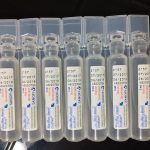Elrexfio: Uses, Benefits, Dosage, Side Effects, Interaction

What is Elrexfio?
Elrexfio, also known generically as elranatamab-bcmm, is a groundbreaking medical treatment developed by Pfizer. Its primary purpose is to combat multiple myeloma (MM), a form of blood cancer that specifically affects plasma cells originating in the bone marrow. This innovative therapy is indicated for use in adults who are grappling with relapsed or refractory multiple myeloma (RRMM), a stage of the disease where previous treatments have not yielded the desired results.
Elrexfio is specifically recommended for individuals who have undergone at least four lines of therapy, which encompass a range of medical approaches. This includes having experienced treatment with a proteasome inhibitor, an immunomodulatory agent, and an anti-CD38 monoclonal antibody. These prerequisites underline the severity of the condition and the targeted approach that Elrexfio offers to individuals whose multiple myeloma has proven to be particularly stubborn or resistant to previous treatments.
The accelerated approval of Elrexfio by the U.S. Food and Drug Administration (FDA) was based on significant clinical evidence, specifically the results of the single-arm Phase 2 MagnetisMM-3 trial. This validation from regulatory authorities underscores the potential of Elrexfio as a transformative treatment option for RRMM patients who have exhausted other therapeutic avenues. It is important to note that the FDA’s approval is granted on the basis of initial promising results, and continued approval for this particular indication is contingent upon further verification of its clinical benefit through ongoing confirmatory trials.
How does Elrexfio work?
Elrexfio works by binding to the surface of multiple myeloma cancer cells in a highly innovative and precise treatment strategy for individuals dealing with relapsed or refractory multiple myeloma (RRMM). At the heart of its mechanism lies its classification as a bispecific antibody, a cutting-edge therapeutic approach that capitalizes on the body’s own immune system to target and destroy cancer cells.
The primary mode of action for Elrexfio revolves around its ability to bind to specific molecules present on the surface of multiple myeloma cancer cells and T-cells, orchestrating a sophisticated interaction that leads to the destruction of the cancerous cells. This process is executed through the precision targeting of two key molecular markers: the B-cell maturation antigen (BCMA) on multiple myeloma cells and the CD3 receptor on T-cells.
The first step of Elrexfio’s action involves its binding to the BCMA surface of multiple myeloma cells. BCMA is a protein that is typically overexpressed on the surface of these cancerous cells, making it an ideal target for therapeutic intervention. By latching onto BCMA, Elrexfio establishes a connection with the multiple myeloma cells, which forms the foundational step of its mechanism.
In a parallel interaction, Elrexfio also binds to the CD3 receptor present in T-cells. T-cells, a vital component of the immune system, play a crucial role in identifying and eliminating abnormal or cancerous cells within the body. The CD3 receptor is a key element in the activation of T-cells, serving as a molecular switch that triggers their immune response.
Elrexfio’s remarkable effectiveness stems from its unique design as a bispecific antibody. By simultaneously binding to BCMA on myeloma cells and CD3 on T-cells, Elrexfio effectively bridges the gap between these two cell types. This bridging action achieves two crucial outcomes. Firstly, it physically brings the T-cells into close proximity with the myeloma cells, ensuring a targeted and direct interaction. Secondly, it triggers the activation of T-cells, prompting them to initiate their immune response.
The activation of T-cells is a pivotal moment in Elrexfio’s mechanism. These activated T-cells launch a targeted attack on the multiple myeloma cells to which Elrexfio is attached. This immune response can lead to the destruction of the cancerous cells, potentially resulting in a reduction of the cancer burden and an improvement in the patient’s condition.
Elrexfio Benefits
Elrexfio offers several significant benefits as a treatment option for individuals dealing with relapsed or refractory multiple myeloma (RRMM), a challenging and complex form of blood cancer. Its unique mechanism of action and therapeutic properties contribute to these notable advantages:
1. Targeted Approach: Elrexfio’s mode of action as a bispecific antibody allows it to precisely target B-cell maturation antigen (BCMA) on multiple myeloma cells and CD3 on T-cells. This specificity minimizes damage to healthy cells, focusing the immune response on cancerous cells, which is particularly beneficial in sparing non-cancerous tissues from unintended harm.
2. Activation of Immune Response: By binding to both BCMA and CD3, Elrexfio bridges the gap between T-cells and cancer cells, leading to the activation of T-cells. This immune response triggers T-cells to attack and destroy myeloma cells, potentially leading to tumor reduction and disease control.
3. Improved Efficacy: Elrexfio’s ability to engage both BCMA and CD3 enhances its overall effectiveness. This approach addresses the limitations of traditional treatments and offers an additional avenue for individuals who have not responded well to previous therapies.
4. Personalized Treatment: As a targeted therapy, Elrexfio can be tailored to the individual’s disease characteristics. This can potentially lead to a more personalized and effective treatment approach, maximizing the chances of positive outcomes.
5. Reduced Side Effects: Because Elrexfio’s mechanism of action targets cancer cells specifically, the potential for off-target effects on healthy cells is minimized. This can translate to a potentially lower risk of systemic side effects often associated with traditional chemotherapy.
6. Alternative for Refractory Cases: For individuals who have relapsed or failed to respond to other treatments, Elrexfio provides a novel therapeutic option. It addresses the challenges posed by resistant myeloma cells and offers renewed hope for disease management.
7. Subcutaneous Administration: Elrexfio’s administration as a subcutaneous injection provides a convenient and well-tolerated method of delivery for patients. This can enhance patient comfort and compliance with the treatment regimen.
8. Potential for Long-Term Disease Control: The immune response triggered by Elrexfio has the potential to lead to sustained disease control, possibly extending the period of remission and improving the overall quality of life.
9. Accelerated FDA Approval: Elrexfio’s approval by the U.S. Food and Drug Administration (FDA) underscores its potential benefits and validates its efficacy based on clinical evidence.
10. Continued Research: Elrexfio’s introduction opens avenues for further research and exploration into bispecific antibodies and their applications in treating multiple myeloma and other cancers.
How Elrexfio is Administered
Receiving Elrexfio as part of your treatment plan involves a specific protocol that ensures its optimal efficacy and your safety. Here’s an overview of how you will receive Elrexfio:
Injection Method: Elrexfio will be administered to you by your healthcare provider through a subcutaneous injection. This means that the medication will be injected just beneath your skin. Typically, the injection site is your stomach area (abdomen), though your thigh or another suitable area of your body may also be used. Your healthcare provider will determine the most appropriate injection site for you.
Step-Up Dosing Schedule: Your treatment with Elrexfio will begin with a “step-up dosing schedule.” This schedule involves receiving a series of doses that gradually increase in size over the initial days of treatment. The purpose of this step-up dosing is to help your body adjust to the medication and minimize any potential side effects.
Specifically, your treatment will start with a dose on Day 1. This is considered a small “step-up” dose to introduce the medication to your system. On Day 4, you will receive a larger “step-up” dose, building on the previous dose. Finally, on Day 8, you will receive the first full “treatment” dose of Elrexfio. This gradual increase in dosage aims to ensure your body’s tolerance and response to the medication.
Ongoing Treatment Schedule: After completing the step-up dosing schedule, your ongoing treatment with Elrexfio will continue. From Week 1 through to Week 24, you will receive the medication once a week. This weekly dosing is designed to maintain the medication’s effectiveness and continue targeting the cancer cells.
Starting from Week 25, the dosing frequency will change. Instead of receiving the medication every week, your future doses will be administered once every two weeks. This adjustment in dosing frequency is a part of the treatment plan to achieve the desired therapeutic outcomes while potentially reducing the number of injections.
Hospitalization After Initial Doses: For your safety and to closely monitor your response to the medication, you will be hospitalized after the first and second doses of Elrexfio. After the first dose on Day 1, you will be hospitalized for 48 hours. After the second dose on Day 4, you will be hospitalized for 24 hours. This period of observation helps ensure that any potential adverse reactions or side effects are promptly addressed and managed.
Pregnancy and Breastfeeding Considerations with Elrexfio
If you are considering or currently undergoing treatment with Elrexfio, it’s important to be aware of its potential effects on pregnancy and breastfeeding. Here’s what you need to know:
Pregnancy
• If you are pregnant, planning to become pregnant, or suspect that you might be pregnant, it is crucial to inform your healthcare provider. Elrexfio has the potential to harm an unborn baby, and this information is essential for your healthcare provider to make informed decisions regarding your treatment plan.
• If you are of childbearing age and are starting treatment with Elrexfio, your healthcare provider will likely request a pregnancy test before you begin treatment. This is to ensure that you are not pregnant prior to starting the medication.
• During the course of treatment with Elrexfio, it’s important to use effective birth control (contraception) methods. This precaution is necessary to prevent pregnancy while undergoing treatment with a medication that could potentially harm a developing fetus.
• Even after completing your treatment with Elrexfio, it is recommended to continue using effective birth control for a period of 4 months after your last dose. This is to ensure that any potential effects of the medication on a developing fetus are minimized.
Breastfeeding
• If you are breastfeeding or planning to breastfeed, you should inform your healthcare provider. The effects of Elrexfio on breast milk and its potential impact on nursing infants are not yet fully understood.
• Currently, it is unknown whether Elrexfio passes into breast milk. To ensure the safety of both you and your infant, it is recommended that you refrain from breastfeeding during your treatment with Elrexfio.
• Following the completion of your treatment, it is also advised not to breastfeed for a duration of 4 months after your last dose. This precautionary measure allows time for any potential remnants of the medication to be eliminated from your system.
Elrexfio Side Effects
When undergoing treatment with Elrexfio, it’s important to be aware of potential side effects that may occur. These side effects can range from common and less severe to more serious and potentially life-threatening. Here is an overview of both common and serious side effects associated with Elrexfio:
Common Side Effects
• Decreased White Blood Cells, Red Blood Cells, and Platelets: Elrexfio may lead to reductions in these blood cell counts. This can contribute to increased fatigue, susceptibility to infections, and bleeding tendencies.
• Tiredness: Feeling tired or fatigued is a common side effect during treatment with Elrexfio.
• Injection Site Reactions: After receiving injections, you might experience reactions such as redness, itching, pain, bruising, rash, swelling, and tenderness at the injection site.
• Diarrhea: Gastrointestinal effects, including diarrhea, may occur as a side effect of Elrexfio treatment.
• Muscle and Bone Pain: Some individuals might experience muscle and bone pain during treatment.
• Decreased Appetite: A reduced desire to eat might occur as a side effect.
• Rash: Skin rash can be a side effect of Elrexfio.
• Cough and Nausea: These symptoms may also manifest as common side effects.
• Fever: A fever might occur, which can be a symptom of an underlying infection.
Serious Side Effects
• Infections: Elrexfio treatment can make you more susceptible to infections, including severe, life-threatening infections. Upper respiratory tract infections and pneumonia are particularly common during treatment. Prompt medical attention is necessary if you develop any signs or symptoms of infection, such as fever, chills, cough, shortness of breath, chest pain, sore throat, pain during urination, or a general feeling of weakness.
• Decreased White Blood Cell Counts: Severe reductions in white blood cell counts can occur, increasing the risk of infections. Fever may indicate low white blood cell counts, which can be a sign of infection.
• Liver Problems: Elrexfio can lead to elevated liver enzymes and bilirubin levels in the blood. Symptoms of liver problems include tiredness, loss of appetite, pain in the upper abdomen, dark urine, and yellowing of the skin or eyes.
Monitoring and Reporting: Your healthcare provider will closely monitor your health and conduct regular blood tests to detect any potential side effects before and during Elrexfio treatment. Depending on the severity of the side effects, your healthcare provider may adjust or temporarily halt your treatment.
If you experience any side effects, it’s important to promptly inform your healthcare provider. If you notice serious or life-threatening symptoms, seek immediate medical attention.
Reporting Side Effects
If you encounter any side effects, it’s recommended to report them to your healthcare provider. You can also report side effects to the U.S. Food and Drug Administration (FDA) by calling 1-800-FDA-1088. This reporting contributes to the understanding of medication safety and can help improve patient care.
Precautions and Considerations While Receiving Elrexfio
When undergoing treatment with Elrexfio, there are certain precautions and actions you should take to ensure your safety and the effectiveness of the treatment. Here’s what you should be mindful of:
Activities to Avoid
Driving and Operating Machinery: During specific periods of your treatment, it is advised not to drive, operate heavy machinery, or engage in potentially dangerous activities. This precaution applies for 48 hours after completing each of the two doses that make up the “step-up dosing schedule,” as well as after your first full treatment dose. Additionally, if you develop any new neurological symptoms such as dizziness, confusion, tremors, sleepiness, or any other symptom that affects your consciousness, you should avoid these activities until the symptoms resolve.
Medication Interactions
It’s important to inform your healthcare provider about all the medications you are taking, including prescription drugs, over-the-counter medicines including other anticancer drugs, vitamins, and herbal supplements. This comprehensive understanding allows your healthcare provider to monitor for potential interactions and make informed decisions regarding your treatment plan.





